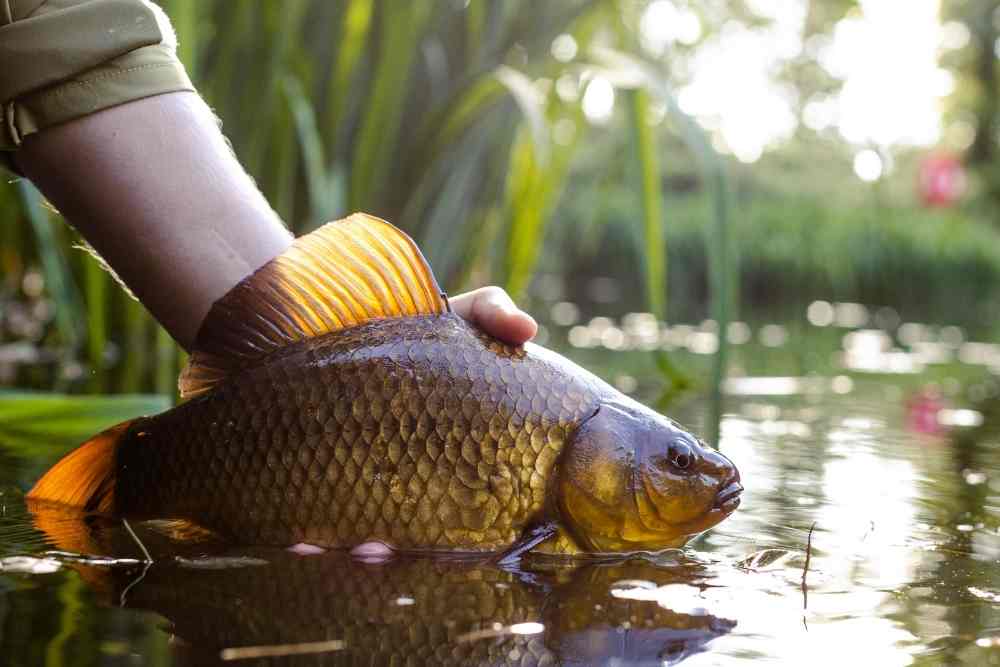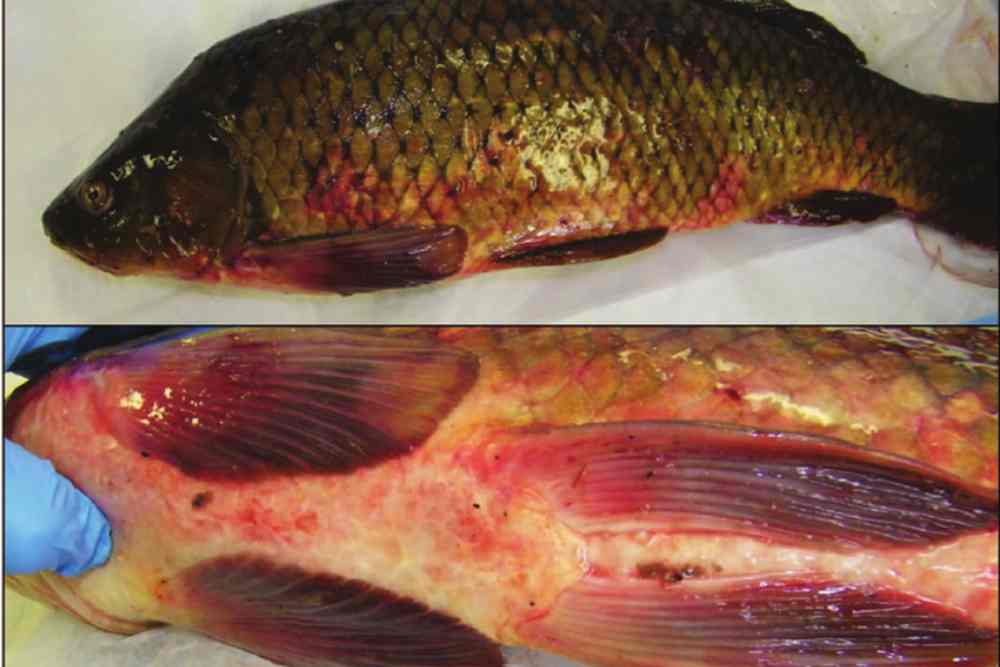Spring Viremia of Carp (SVC) is a highly contagious and deadly virus that affects carp fish species around the world.
It is a dangerous illness that mostly affects the common carp Cyprinus carpio and other cyprinids (SVC). The illness is widespread in European carp culture and significantly affects morbidity and mortality.
SVC is a viral infection caused by the Rhabdovirus carpio and can lead to significant mortality rates in affected populations of carp.
Treatment for the disease is limited, so it is important to take steps to prevent it from happening in the first place.

What is the Causative Agent of Spring Viremia of Carp?
Communal carp the fish the major host of SVCV is the fish Cyprinus carpio. Young fish are the virus’ primary victim, despite the fact that it can harm carp of all ages.
Spring viremia of carp is a virus that affects common carp and other members of the Cyprinidae family. The virus is spread through the water and can infect fish of all sizes.
Species affected: The only other fish are crucian and koi carp. SVC outbreaks have been reported in C. carpio. Carassius, the large-headed Hypophthalmichthys molitrix, Aristichthys nobilis, a silver carp, and Silurus glanis, a sheatfish.
Carp that have survived an epizootic, ill fish and other cultured or wild fish that could serve as SVCV carriers are reservoir hosts.
Vector: Fish-eating birds like herons, leeches (Piscicola geometry), carp louse (Argulus foliaceus), and others are examples of potential biological vectors.
The ability of the fruit fly Drosophila melanogaster to multiply SVCV in an experimental setting has been proven.
Water arthropods may transmit SVCV, but only terrestrial insects are not believed to be involved in the disease’s spread.
These crustaceans developed histological alterations as a result of the replication of the SVCV-like material that was found in Hawaii’s shrimp.
Transmission of Spring Viremia
The virus is thought to be transmitted through the water column, and infected fish may shed the virus for several weeks.
The majority of the virus is discharged in the feces and urine of carriers and clinically infected fish.
Leeches and carp louse, two parasites that draw blood, may also mechanically transfer the SVCV, which is thought to spread predominantly through the water.
Spring Viremia of Carp Symptoms

The spring viremia of carp is a viral disease that affects common carp and other cyprinid fish.
So, what are the clinical signs of spring viremia of carp?
The disease is characterized by an acute onset of hemorrhagic septicemia, which can lead to high mortality rates in affected populations.
Symptoms of the virus include hemorrhaging, bulging eyes, and swollen organs.
–Abdominal distension, exophthalmia, inflammation or edema of the cranial vent (often with acrid paralimnalia gastrointestinal feces), and petechial hemorrhages of the skin, gills, and eyes.
–The body is often darkened by pale gills.
-The ill fish tend to gather at the water stream or sides of the pond, swim, and breathe slowly than normal and moderately to slowly react to stimuli.
-Infected fish experience bleeding, a disturbance in the water-salt balance, and decreased immune function because the kidney, spleen, and liver tissues are destroyed. In the spring, high mortality occurs in waters between 10 and 17 °C.
-Infected carp develop humoral antibodies that can inhibit the virus from spreading in warmer climates, and these carp are highly resistant to re-infection.
Spring Viremia of Carp Treatment
Spring viremia in carp is a viral disease that can be difficult to treat once a fish is infected. However, there are several steps that can be taken to manage the disease and minimize its impact on the carp population:
Isolate infected fish: If a fish is suspected to be infected with spring viremia, it should be isolated from healthy fish to prevent the disease from spreading.
Increasing temperature: SVC outbreaks can be stopped or avoided by elevating the temperature over 20°C with a controlled atmosphere.
Supportive care: Providing supportive care to infected fish can help improve their chances of recovery. This can include maintaining good water quality, providing proper nutrition, and minimizing stress.
Antiviral medication: There are currently no specific antiviral medications available for the treatment of spring viremia in carp. However, some broad-spectrum antiviral drugs have been shown to be effective in laboratory studies and may be used in certain cases.
Vaccination: Vaccination is the most effective way to prevent spring viremia in carp. However, once a fish is infected, vaccination will not be effective in treating the disease.
Prevention is the best approach to managing spring viremia in carp, as it can be difficult to treat once a fish is infected.
It has not yet been possible to select, hybridize, or genetically modify a tested and authorized strain of carp that is resistant to SVC.
By practicing good biosecurity measures and vaccinating fish, it’s possible to prevent the spread of the disease and maintain a healthy carp population.
How Do You Prevent Spring Viremia in Carp?
Spring viremia in carp is a viral disease that can cause significant mortality in carp populations. To prevent spring viremia in carp, there are several steps that can be taken:
Maintain high water quality: Spring viremia in carp can be exacerbated by poor water quality. Therefore, it’s important to ensure that water quality is high by monitoring parameters such as dissolved oxygen, pH, temperature, and ammonia levels.
Practice good biosecurity: Spring viremia in carp can be transmitted from infected fish to healthy ones through contaminated water, equipment, and personnel.
Therefore, it’s important to practice good biosecurity measures, such as quarantining new fish, disinfecting equipment, and restricting visitor access to the facility.
Vaccinate fish: Vaccination is an effective way to prevent spring viremia in carp. There are several commercial vaccines available for spring viremia in carp, and they can be administered through injection or immersion.
Implement a management plan: Developing a management plan for the facility can help prevent the spread of spring viremia in carp.
This plan should include measures such as regular monitoring for signs of disease, isolation and treatment of sick fish, and proper disposal of dead fish.
By implementing these steps, it’s possible to prevent spring viremia in carp and maintain a healthy fish population.
FAQs
What is septicemia?
Septicemia is a serious medical condition characterized by the presence of bacteria or other microorganisms and their toxins in the bloodstream. It is also commonly known as blood poisoning.
Septicemia can occur when bacteria or other microorganisms invade the body through a wound, infection, or other means, and then spread into the bloodstream.
Once in the bloodstream, the microorganisms can travel throughout the body and cause damage to various organs and tissues.
The toxins released by the microorganisms can also cause inflammation and damage to blood vessels, leading to a decrease in blood pressure and poor blood flow to vital organs.
It is a medical emergency and requires immediate treatment with antibiotics and supportive care, such as intravenous fluids and oxygen therapy. If left untreated, septicemia can lead to organ failure, shock, and even death.
What is viremia?
Viremia is a medical condition in which a virus is present in the bloodstream of an infected person or animal. This occurs when a virus invades the body and replicates within host cells, leading to the release of viral particles into the bloodstream.
Viremia can occur during the early stages of infection and can last for varying amounts of time depending on the virus and the immune response of the infected individual.
Viremia can also increase the risk of transmission of the virus to other individuals, as the virus is present in the bloodstream and can be spread through bodily fluids.
Viremia can be detected through laboratory testing, such as a viral load test or PCR test.
References
- Dikkeboom, A. L., Radi, C., Toohey-Kurth, K., Marcquenski, S., Engel, M., Goodwin, A. E., … & Longshaw, C. (2004). First report of spring viremia of carp virus (SVCV) in wild common carp in North America. Journal of Aquatic Animal Health, 16(4), 169-178.
- Teng, Y., Liu, H., Lv, J. Q., Fan, W. H., Zhang, Q. Y., & Qin, Q. W. (2007). Characterization of complete genome sequence of the spring viremia of carp virus isolated from common carp (Cyprinus carpio) in China. Archives of virology, 152, 1457-1465.
- Phelps, N. B., Armién, A. G., Mor, S. K., Goyal, S. M., Warg, J. V., Bhagyam, R., & Monahan, T. (2012). Spring viremia of carp virus in Minnehaha Creek, Minnesota. Journal of Aquatic Animal Health, 24(4), 232-237.
- Emmenegger, E. J., & Kurath, G. (2008). DNA vaccine protects ornamental koi (Cyprinus carpio koi) against North American spring viremia of carp virus. Vaccine, 26(50), 6415-6421.
- Ahne, W. (1986). The influence of environmental temperature and infection route on the immune response of carp (Cyprinus carpio) to spring viremia of carp virus (SVCV). Veterinary Immunology and Immunopathology, 12(1-4), 383-386.
